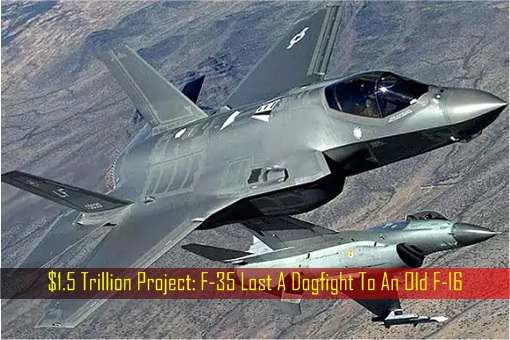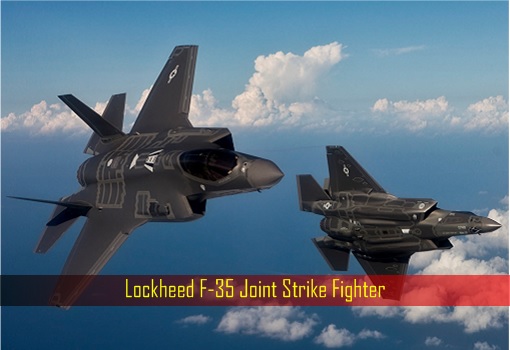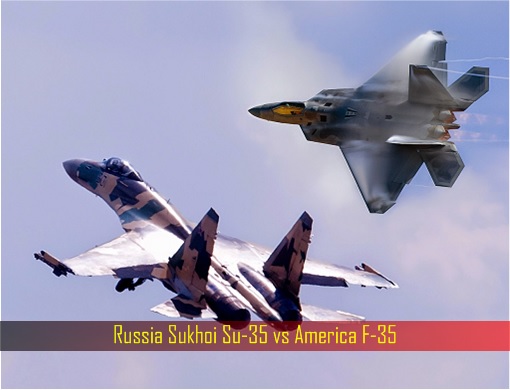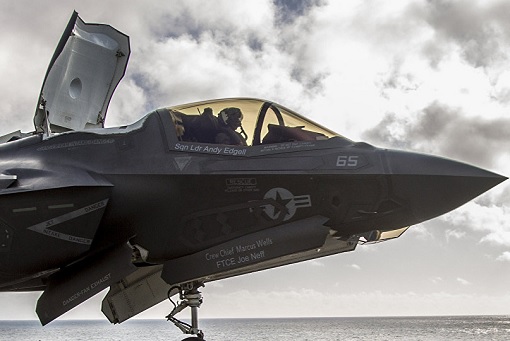The F-35 was supposed to be the ultimate flying machine, a fighter jet that could do almost everything the U.S. military desired. At least that was the marketing pitch trumpeted by its manufacturer Lockheed Martin. The “one design fits all” would see the F-35 serves the U.S. Air Force, Marine Corps and Navy. The marketing stunt didn’t stop there, mind you.
Marketed as cost-effective, powerful multi-role fighter plane and the most advanced fighter jet the world has ever seen, Lockheed promised that the new F-35 would be “4 times more effective” in air-to-air combat, “8 times more effective” in air-to-ground combat and “3 times more effective” in recognizing and suppressing an enemy’s air defences.
It was as if Lockheed Martin had travelled through a time machine to the future and came back with this piece of awesome technology. Turns out – it was nothing but a scam as the F-35 couldn’t do any of those things. In Jan 2015 when F-35 and F-16 were pitted against each other in a combat test, the F-35 test pilot noted that the plane was less manoeuvrable and inferior to the F-16 in a visual-range dogfight.

More importantly, the F-35 is not invisible when it’s supposed to be “stealthy”. It could be seen on radar, albeit looking smaller on the screen and might be mistaken as a bird. If this fighter jet were to go to combat against the Russians, who have excellent passive infrared search and tracking systems, the American plane could be blasted to pieces before the pilot realized what hit him.
In fact, Pierre Sprey, a co-designer of F-16, has nothing but criticism for the sophisticated F-35. He said that the F-35 would likely lose a close-in combat encounter to a well-flown MiG-21, a 1950s Soviet fighter design. But with multiple defects and problems – up to 931 open documented deficiencies as of March 2016 – who needs enemy such as Russia to defeat the F-35 fighter jets?
Officially begun in 2001, with roots extending back to the late 1980s, the F-35 program is nearly a decade behind schedule. In spite of being the most expensive defence program in world history – at US$1.5 trillion – it has failed to meet many of its original design requirements. The U.S. has since decided that the F-35 joint strike fighter will fly until 2070.

The F-35 program made up 20% of Lockheed’s total 2015 revenue of US$46.1 billion. Obviously, it was a lucrative cash-cow considering even President Trump was flabbergasted that American taxpayers were charged a staggering US$379 billion for 2,443 of the F-35 fighter jets – costing more than US$150 million a pop.
In comparison, the extremely reliable Russian Sukhoi Su-35 cost only US$50 million a pop while the Lockheed-made F-35 ranges from US$157 million to US$355 million (just the production cost), depending whether it was for Air Force (F-35A), Marine Corps (F-35B) or Navy (F-35C). But the scam started even before a single F-35 could be ready for service.
Cost overruns and development delays had already cost taxpayers a mind-boggling US$400 billion before a single plane could fly. The unit cost per plane is roughly twice what was promised early on. The greatest part of the scam was when even the Pentagon was convinced that the F-35 “too big to fail”, and decided to throw more money into the project.

Like any other successful scam, Lockheed managed to sell the story that just because taxpayers have flushed more than US$100 billion (Congress’ authorization in spending last year) down the disgraceful toilet so far, Americans must continue to throw billions more down that same toilet, with the hope that it could work one day.
Former Defense Secretary Ash Carter famously said – “If we stay on course, no other fighter aircraft in the world will come close to competing with the F-35 for performance and cost, and we will wipe out all competition.” He, of course, conveniently ignored the problematic and defective 8-million lines of software code, on top of 24-million lines of buggy code in its maintenance and logistic software.
The biggest mistake began when Pentagon and Lockheed Martin agreed to share aircraft design across different branches of the military. In a 2013 study, RAND Corporation found that it would have been cheaper if the Air Force, Marine Corps and Navy had simply designed and developed separate and more specialized aircraft to meet their specific operational requirements.

Now, the U.S. military has signalled that it might cancel essential upgrades for more than 100 early model F-35 stealth fighters flown by the Air Force – because embarrassingly, those fighter jets actually can’t fight due to incompatibility with the latest weapons. That means 6% of 1,700-mighty F-35 fleet – costing a whopping US$20 billion – are unfit for combat.
Yes, Pentagon knew about the problems of the project from the beginning and now decides as many as 108 older F-35A would be skipped for upgrades because their so-called “Block 2B software” can’t be upgraded. If insisted, F-35 must be accompanied by friendly forces such as F-22 Raptor. Instead, the U.S. military has asked Congress to fund another 70 newer F-35 in 2018 for US$10.3 billion.
Other Articles That May Interest You …
- Why Didn’t The U.S. Shoot Down Kim’s Missile? The Answer Is Quite Embarrassing
- After Air Force One, Now Trump Attacks Lockheed’s Overpriced F-35 Stealth Fighter
- China’s Naughty Act Of War – Snatches U.S. Navy Submarine Drone & Sails Away!!
- Documents Prove “New Air Force One” Overpriced – Trump Was Right … Again
- Panic!! Russia’s Aircraft Carrier Leading A Fleet Of Warships Towards Mediterranean
- Here Are Russia’s 3 Awesome Weapons Which The U.S. Is Absolutely Terrified Of
- Checkmate – Russia Sends New Weapon “S-300V4 Gladiator” To Syria
- Putin To Send Aircraft Carrier To Syria – To Wipe Out ISIS, To Humiliate NATO

|
|
October 17th, 2017 by financetwitter
|


|

|

|

|

|

|




























Comments
Add your comment now.
Leave a Reply